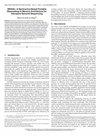Smart Memory: Deep Learning Acceleration in 3D-Stacked Memories
IF 1.4
3区 计算机科学
Q4 COMPUTER SCIENCE, HARDWARE & ARCHITECTURE
引用次数: 0
Abstract
Processing-in-memory (PIM) is the most promising paradigm to address the bandwidth bottleneck in deep neural network (DNN) accelerators. However, the algorithmic and dataflow structure of DNNs still necessitates moving a large amount of data across banks inside the memory device to bring input data and their corresponding model parameters together, negatively shifting part of the bandwidth bottleneck to the in-memory data communication infrastructure. To alleviate this bottleneck, we present智能存储器:在三维堆叠存储器中加速深度学习
内存处理(PIM)是解决深度神经网络(DNN)加速器带宽瓶颈的最有前途的模式。然而,DNN 的算法和数据流结构仍然需要在内存设备内部的存储库之间移动大量数据,以便将输入数据及其相应的模型参数汇集到一起,这就将部分带宽瓶颈转移到了内存数据通信基础设施上。为了缓解这一瓶颈,我们提出了智能内存(Smart Memory),这是一种适用于三维内存的高度并行内存 DNN 加速器,得益于可扩展的高带宽内存网络。现有的 PIM 设计是在底层 3D 存储器的逻辑芯片上实现计算单元和片上网络,而在 Smart Memory 中,计算和数据传输任务则分布在各个存储器组中。为此,每个内存组都配备了:(1)一个非常简单的处理单元,用于运行神经网络;(2)一个电路交换路由器,用于通过三维内存网络互连内存组。我们的评估显示,与最先进的内存神经网络加速器相比,平均性能提高了 44%。
本文章由计算机程序翻译,如有差异,请以英文原文为准。
求助全文
约1分钟内获得全文
求助全文
来源期刊

IEEE Computer Architecture Letters
COMPUTER SCIENCE, HARDWARE & ARCHITECTURE-
CiteScore
4.60
自引率
4.30%
发文量
29
期刊介绍:
IEEE Computer Architecture Letters is a rigorously peer-reviewed forum for publishing early, high-impact results in the areas of uni- and multiprocessor computer systems, computer architecture, microarchitecture, workload characterization, performance evaluation and simulation techniques, and power-aware computing. Submissions are welcomed on any topic in computer architecture, especially but not limited to: microprocessor and multiprocessor systems, microarchitecture and ILP processors, workload characterization, performance evaluation and simulation techniques, compiler-hardware and operating system-hardware interactions, interconnect architectures, memory and cache systems, power and thermal issues at the architecture level, I/O architectures and techniques, independent validation of previously published results, analysis of unsuccessful techniques, domain-specific processor architectures (e.g., embedded, graphics, network, etc.), real-time and high-availability architectures, reconfigurable systems.
 求助内容:
求助内容: 应助结果提醒方式:
应助结果提醒方式:


